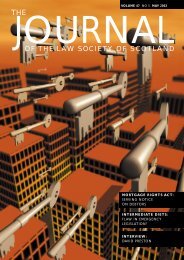Coulsfield reports civil justice as ripe for review Coulsfield reports ...
Coulsfield reports civil justice as ripe for review Coulsfield reports ...
Coulsfield reports civil justice as ripe for review Coulsfield reports ...
Create successful ePaper yourself
Turn your PDF publications into a flip-book with our unique Google optimized e-Paper software.
PENSIONS<br />
As pensions “A-Day” approaches, IAIN TALMAN explains<br />
how the statutory regime is taking shape and the actions<br />
advisers should be taking between now and 1 April<br />
PUZZLES and<br />
PARADOXES<br />
Q When can you simplify law and make it more<br />
complicated at the same time?<br />
A When it is pensions law.<br />
Q How can you make pensions more secure, less<br />
complicated, cost less but better funded?<br />
A Become a Government Minister and say so.<br />
L<strong>as</strong>t year the Pensions Act 2004<br />
attempted to deregulate some parts<br />
of pensions law and make pensions<br />
safer. It also sought to introduce a<br />
new funding requirement to make<br />
them more secure. Some but not all<br />
of its provisions have come into<br />
<strong>for</strong>ce.<br />
The Finance Act 2004 (now<br />
amended by the Finance Act 2005)<br />
will introduce from April 2006 a<br />
simplified Revenue and Customs<br />
regime.<br />
These two me<strong>as</strong>ures were<br />
examined in the article “Securing<br />
the future” in April’s Journal (page<br />
19).This article is an update on<br />
where we have got to now.<br />
Simplification<br />
It may be recalled that at present<br />
we have a complicated approval<br />
system to enable a pension scheme<br />
to gain the tax exempt advantages.<br />
This involves keeping benefits<br />
provided within the permitted types<br />
and keeping those within the<br />
permitted level of benefit. From 6<br />
April 2006 (“A-Day”) this is to be<br />
22 :<br />
The Journal: December 2005<br />
swept away by a “simplified” system,<br />
b<strong>as</strong>ed on a lifetime allowance of<br />
£1.5m <strong>for</strong> the individual’s pension<br />
fund and annual contribution limits.<br />
Most of the statutory instruments<br />
under this legislation have now been<br />
made. Revenue & Customs have<br />
begun (without wide consultation)<br />
to issue the “simplified” manual but<br />
by the internet.The <strong>for</strong>mat and<br />
content are equally baffling.<br />
There are opportunities here which<br />
solicitors must seize both personally<br />
and <strong>as</strong> advisers.Whether employees<br />
or, more particularly, self-employed,<br />
solicitors should be examining their<br />
pension plans and advising clients to<br />
do likewise.<br />
This considerable liberalisation of<br />
rules in 2006 should be taken<br />
advantage of and planning begun<br />
now.<br />
Self-employed<br />
The self-employed may privately<br />
provide <strong>for</strong> pensions through a<br />
personal pension scheme, which will<br />
attract tax advantages. Rather than<br />
investing through a provider such <strong>as</strong><br />
the insurance company, the<br />
individual also h<strong>as</strong> the option of a<br />
SIPP or self-invested personal<br />
pension scheme.This w<strong>as</strong> examined<br />
in David Canning’s article in the<br />
September Journal (page 30).<br />
Employed (including directors)<br />
In addition to use of the personal<br />
pension scheme and SIPPs, the<br />
employed may also use a group or<br />
occupational pension scheme. Again<br />
this may take the <strong>for</strong>m of an<br />
arrangement which is fully insured<br />
and no doubt insurers will be<br />
continuing their executive pension<br />
plans <strong>as</strong> be<strong>for</strong>e within the context<br />
of the new rules.<br />
There is also the option of selfadministering<br />
the <strong>as</strong>sets, which<br />
became familiar <strong>as</strong> a small selfadministered<br />
scheme (or SSAS).<br />
From April 2006 essentially these<br />
will continue to be available, but on<br />
a much simplified b<strong>as</strong>is – without<br />
many of the restrictions which had<br />
accresced to them previously.The<br />
rules will now be similar to those<br />
<strong>for</strong> a SIPP but with some<br />
differences, such <strong>as</strong> the power to<br />
lend to the sponsoring employer.<br />
The SSAS may come back into its<br />
own and will have some attractive<br />
features including, perhaps more<br />
readily, the ability to shift the value<br />
between generations who are<br />
members of the scheme.They<br />
should certainly not be overlooked<br />
in planning.<br />
Group schemes<br />
Those advising employers with or<br />
trustees of group pension schemes<br />
should also be suggesting a number<br />
of are<strong>as</strong> <strong>for</strong> <strong>review</strong>, some of which<br />
relate to higher level policy<br />
decisions and some of which relate<br />
to administrative issues.<br />
At the higher level the following<br />
require examination:<br />
■ benefit design issues.There are<br />
several changes, particularly in<br />
relation to benefits which can be<br />
provided, perhaps most strikingly in<br />
relation to death benefits.These<br />
should be <strong>review</strong>ed.<br />
■ potential flexibilities at retirement.<br />
Although minimum retirement age<br />
www.journalonline.co.uk










